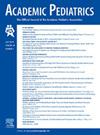母亲教育与儿童自我调节:母亲的自我调节和反应能力是否能调节两者之间的关系?
IF 3
3区 医学
Q1 PEDIATRICS
引用次数: 0
摘要
研究观察到的母亲反应能力和母亲自我调节能力对母亲教育和儿童自我调节能力之间关联的中介作用。从之前的一项研究中招募了讲英语的母子二人组(n=189),如果孩子在 2020-2021 学年或 2021-2022 学年开始时符合上幼儿园的条件,则符合条件。主要测量指标包括(DERS-SF) 表示母亲的情绪自我调节能力,(CARE) 表示母亲的反应能力,(HTKS) 表示儿童的自我调节能力。通过线性回归分析了母亲受教育年限与儿童自我调节之间的关系,随后通过四个步骤对两者之间的关系进行了中介分析。这些步骤通过一系列线性回归进行检验,并使用贝塔权重来描述两者之间的关联。每个潜在的中介因素都分别进行了研究。母亲教育程度较高的儿童的自我调节能力明显较强,斜率为 1.3(95% CI 0.3,2.4,p=0.015,β=0.18)。此外,教育程度较高的母亲的观察反应性也明显较高。贝塔权重为 0.34(p<0.001),支持母亲反应性作为中介因素。最后,在直接和间接效应检验中,观察到的母亲反应性解释了母亲教育与儿童自我调节之间关联的 29% (95% CI 3.3%,115%)。这项研究强调了与儿童自我调节能力有关的一个关键机制,以及观察到的母亲反应性在解释母亲教育与儿童自我调节之间的关联方面所起的重要作用。本研究的分析表明,在母亲教育与儿童自我调节之间的关系中,起中介作用的是观察到的母亲反应能力,而不是母亲报告的自我调节能力。本文章由计算机程序翻译,如有差异,请以英文原文为准。
Maternal Education and Child Self-Regulation: Do Maternal Self-Regulation and Responsiveness Mediate the Association?
Objective
To examine the mediating role of observed maternal responsiveness and maternal self-regulation on the association between maternal education and children’s self-regulation.
Methods
English-speaking mother-child dyads (n = 189) were recruited from a previous study and were eligible if the child was kindergarten eligible at the start of the 2020 to 2021 or 2021 to 2022 school year. Key measures included: Difficulties in Emotion Regulation Scale—Short Form for maternal emotional self-regulation, Culturally Affirming and Responsive Experiences for maternal responsiveness, and the Head-Toes-Knees-Shoulders for child self-regulation. The association between years of maternal education and child self-regulation was examined with linear regression, and the mediation analyses utilized 4 subsequent steps examining their relations. These steps were checked through a series of linear regressions, and beta weights were used to describe associations. Each potential mediator was examined separately.
Results
Children of mothers with higher education had significantly higher self-regulation, slope of 1.3 (95% confidence interval 0.3, 2.4, P = 0.015, beta = 0.18). Further, mothers with higher education had significantly higher observed responsiveness. The beta-weight of 0.34 (P < 0.001) supported maternal responsiveness as a mediator. Finally, in the test for direct and indirect effects, observed maternal responsiveness explained 29% (95% confidence interval 3.3%, 115%) of the association between maternal education and child self-regulation.
Conclusions
This study highlights a key mechanism related to children’s self-regulation skills and the significant role of observed maternal responsiveness in explaining the association between maternal education and child self-regulation.
求助全文
通过发布文献求助,成功后即可免费获取论文全文。
去求助
来源期刊

Academic Pediatrics
PEDIATRICS-
CiteScore
4.60
自引率
12.90%
发文量
300
审稿时长
60 days
期刊介绍:
Academic Pediatrics, the official journal of the Academic Pediatric Association, is a peer-reviewed publication whose purpose is to strengthen the research and educational base of academic general pediatrics. The journal provides leadership in pediatric education, research, patient care and advocacy. Content areas include pediatric education, emergency medicine, injury, abuse, behavioral pediatrics, holistic medicine, child health services and health policy,and the environment. The journal provides an active forum for the presentation of pediatric educational research in diverse settings, involving medical students, residents, fellows, and practicing professionals. The journal also emphasizes important research relating to the quality of child health care, health care policy, and the organization of child health services. It also includes systematic reviews of primary care interventions and important methodologic papers to aid research in child health and education.
 求助内容:
求助内容: 应助结果提醒方式:
应助结果提醒方式:


